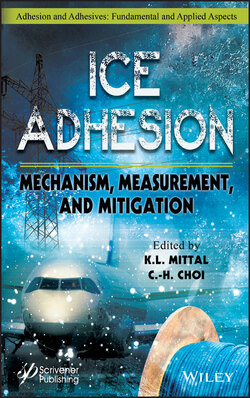Читать книгу Ice Adhesion - Группа авторов - Страница 2
Table of Contents
Оглавление1 Cover
4 Preface
5 Part 1: FUNDAMENTALS OF ICE FORMATION AND CHARACTERIZATION 1 Factors Influencing the Formation, Adhesion, and Friction of Ice 1.1 A Brief History of Man and Ice 1.2 A Thermodynamically Designed Anti-Icing Surface 1.3 The Adhesion of Ice to Surfaces 1.4 The Sliding Friction of Ice 1.5 Summary References 2 Water and Ice Nucleation on Solid Surfaces 2.1 Introduction 2.2 Classical Nucleation Theory 2.3 Prospects 2.4 Summary Acknowledgement References 3 Physics of Ice Nucleation and Growth on a Surface 3.1 Ice Nucleation 3.2 Ice Growth 3.3 Ice Bridging Phenomenon 3.4 Summary References 4 Condensation Frosting 4.1 Introduction 4.2 Why Supercooled Condensation? 4.3 Inter-Droplet Freeze Fronts 4.4 Dry Zones and Anti-Frosting Surfaces 4.5 Summary and Future Directions References 5 The Role of Droplet Dynamics in Condensation Frosting 5.1 Introduction 5.2 Nucleation 5.3 Growth 5.4 Coalescence and Sweeping 5.5 Regeneration or Re-Nucleation 5.6 Inception of Freezing 5.7 Freezing Front Propagation 5.8 Ice Bridging 5.9 Frost Growth and Densification 5.10 Concluding Discussion Acknowledgments References 6 Defrosting Properties of Structured Surfaces 6.1 Introduction: Defrosting on Smooth Surfaces 6.2 Defrosting Heat Exchangers 6.3 Dynamic Defrosting on Micro-Grooved Surfaces 6.4 Dynamic Defrosting on Liquid-Impregnated Surfaces 6.5 Dynamic Defrosting on Nanostructured Superhydrophobic Surfaces 6.6 Summary and Future Directions References
6 Part 2: ICE ADHESION AND ITS MEASUREMENT 7 On the Relationship between Surface Free Energy and Ice Adhesion of Flat Anti-Icing Surfaces 7.1 Introduction 7.2 Types of Ice Formation 7.3 Work of Adhesion, Wettability and Surface Free Energy 7.4 Factors Affecting Ice Adhesion Strength and its Standardization 7.5 Effect of Water Contact Angle and Surface Free Energy Parameters on Ice Adhesion Strength 7.6 Summary References 8 Metrology of Ice Adhesion 8.1 Theory of Ice Adhesion to a Surface 8.2 Centrifugal Force Method 8.3 Peak Force Method 8.4 Tensile Force Method 8.5 Standard Procedure for Ice Adhesion Measurement 8.6 Summary References 9 Tensile and Shear Test Methods for Quantifying the Ice Adhesion Strength to a Surface Glossary 9.1 Introduction 9.2 About Ice, Impact Ice, and Ice Adhesion Tests 9.3 Review of Ice Adhesion Test Methods 9.4 Prospects 9.5 Summary Acknowledgements References 10 Comparison of Icephobic Materials through Interlaboratory Studies 10.1 Introduction 10.2 Icephobicity and Anti-Icing Surfaces 10.3 Ice Formation and Properties 10.4 Testing Ice Adhesion 10.5 Comparing Low Ice Adhesion Surfaces with Interlaboratory Tests 10.6 Concluding Remarks References
7 Part 3: METHODS TO MITIGATE ICE ADHESION 11 Mechanisms of Surface Icing and Deicing Technologies 11.1 A Brief Description of Icing and Ice Adhesion 11.2 Examples of Mathematical Modeling of Icing on Various Static or Moving Surfaces 11.3 New Applications of Common Deicing Compounds 11.4 Plasma-Based Deicing Systems 11.5 Functional Super (Hydrophilic) or Wettable Polymeric Coatings to Resist Icing 11.6 Nanoscale Carbon Coatings with/without Resistive Heating 11.7 Antifreeze Proteins 11.8 Summary and Perspectives References 12 Icephobicities of Superhydrophobic Surfaces 12.1 Introduction 12.2 Anti-Icing Property of Superhydrophobic Surfaces under Dynamic Flow Conditions 12.3 Analytical Models of Depinning Force on Superhydrophobic Surfaces 12.4 Analytical Models of Contact Angles on Superhydrophobic Surfaces 12.5 De-Icing Property of Superhydrophobic Surfaces under Static Conditions 12.6 Conclusions Acknowledgments References 13 Ice Adhesion and Anti-Icing Using Microtextured Surfaces 13.1 Introduction 13.2 Microtextured Surfaces: Wetting Characteristics and Anti-Icing Properties 13.3 Measurement Methods for Ice Adhesion 13.4 Fabrication Methods for Microtextured Surfaces 13.5 Microtextured Surfaces and Anti-Icing Applications 13.6 Conclusion and Future Outlook Acknowledgments References 14 Icephobic Surfaces: Features and Challenges 14.1 Introduction 14.2 Features and Challenges in Rational Fabrication of Icephobic Surfaces 14.3 Wettability 14.4 Surface Engineering 14.5 De-Icing 14.6 Summary References 15 Bio-Inspired Anti-Icing Surface Materials Glossary of Symbols Glossary of Abbreviations 15.1 Introduction 15.2 Depressing Ice Nucleation 15.3 Retarding Ice Propagation 15.4 Reducing Ice Adhesion 15.5 All-in-One Anti-Icing Materials 15.6 Summary and Conclusions References 16 Testing the Durability of Anti-Icing Coatings 16.1 Introduction 16.2 Icing/Deicing Tests and Ice Types 16.3 Concluding Remarks References 17 Durability Assessment of Icephobic Coatings 17.2 UV-Induced Degradation 17.3 Hydrolytic Degradation of Coatings 17.4 Atmospheric Conditions and Changes in Coating Performance 17.5 Mechanical Durability of Coating 17.6 Methods for Durability Assessment of an Icephobic Coating 17.7 Summary References 18 Experimental Investigations on Bio-Inspired Icephobic Coatings for Aircraft Inflight Icing Mitigation 18.1 Introduction About Aircraft Icing Phenomena 18.2 Impact Icing Pertinent to Aircraft Icing vs. Conventional Frosting or Static Icing 18.3 State-of-the-Art Bio-Inspired Icephobic Coatings 18.4 Comparison of Ice Adhesion Strengths of Different Bio-Inspired Icephobic Coatings 18.5 Durability of the Bio-Inspired Icephobic Coatings under High-Speed Droplet Impacting 18.6 Icing Tunnel Testing to Evaluate the Effectiveness of the Icephobic Coatings for Impact Icing Mitigation 18.7 Summary Acknowledgments References 19 Effect of and Protection from Ice Accretion on Aircraft Glossary 19.1 Introduction 19.2 Fundamental Icing Parameters 19.3 Types of Ice on Aircraft 19.4 Aircraft Icing Effects 19.5 Sensing of and Protection from Aircraft Icing 19.6 Summary Funding and Acknowledgement References 20 Numerical Modeling and Its Application to Inflight Icing 20.1 Introduction 20.2 Aircraft Icing 20.3 Numerical Technique for Inflight Icing 20.4 Numerical Simulation of Icing Protection System (IPS) 20.5 Numerical Issues in the Inflight Icing Code 20.6 Summary References
8 Index
